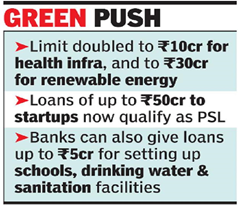Revised Priority Sector Lending (PSL) Guidelines
- Posted By
10Pointer
- Categories
Economy
- Published
8th Sep, 2020
-
- Recently, the Reserve Bank of India (RBI) released revised Priority Sector Lending (PSL) guidelines.
- It aligns with emerging national priorities and also bring sharper focus on inclusive development.
- The PSL guidelines were last reviewed for commercial banks in April 2015 and for Urban Co-operative Banks (UCBs) in May 2018.
- Additional Categories covered under to PSL are
- Bank finance to start-ups up to Rs. 50 crore,
- Loans to farmers for installation of solar power plants for solarisation of grid connected agriculture pumps.
- Loans for setting up Compressed Biogas plants.
- Revised Guidelines includes the following
- Higher credit limit has been specified for Farmers Producers Organizations (FPOs) undertaking farming with assured marketing of their produce at a predetermined price.
- It has defined farmers with land holding of up to one hectare as marginal farmers, and farmers with a landholding of more than one hectare and up to 2 hectares as small farmers.
- The credit limits for renewable energy, health infrastructure, including the projects under ‘Ayushman Bharat’, have been doubled.
- Higher weightage has been assigned to priority sector credit in ‘identified districts’ where priority sector credit flow is comparatively low.
- The RBI mandates banks to lend a certain portion of their funds to specified sectors, like
- Agriculture,
- Micro, Small and Medium Enterprises (MSMEs),
- Export credit,
- Education,
- Housing,
- Social infrastructure,
- Renewable energy.
- All scheduled commercial banks and foreign banks (with a sizable presence in India) are mandated to set aside 40% of their Adjusted Net Bank Credit (ANDC) for lending to these sectors.
- Regional rural banks, co-operative banks and small finance banks have to allocate 75% of ANDC to PSL.



